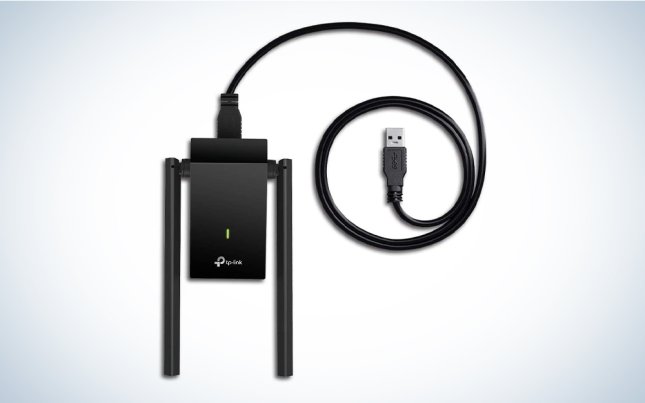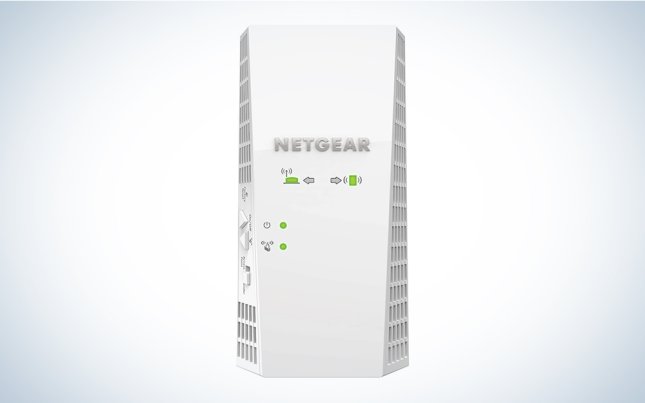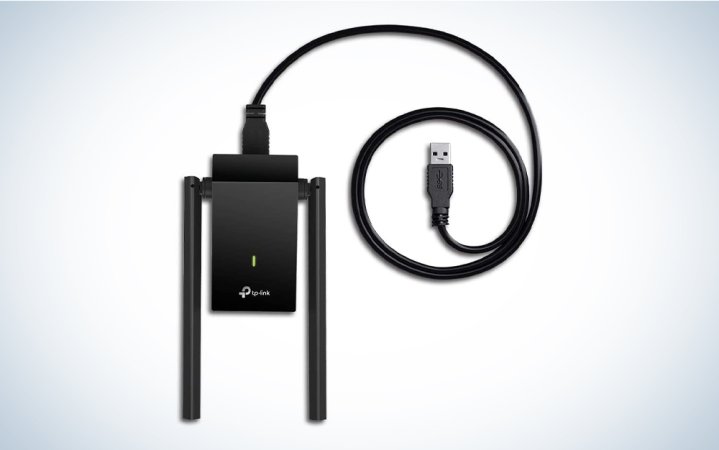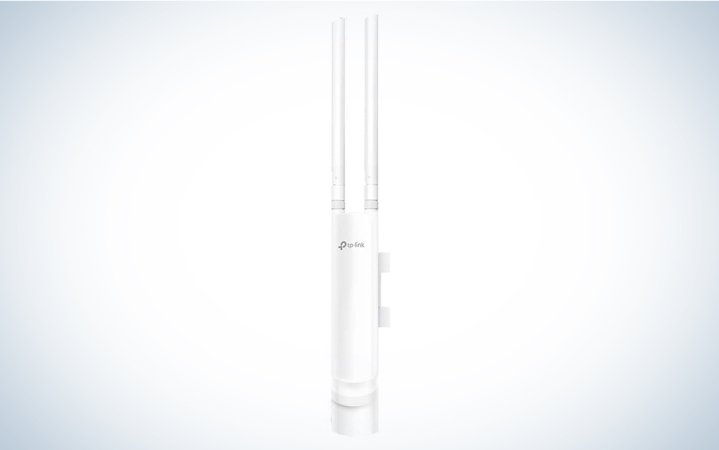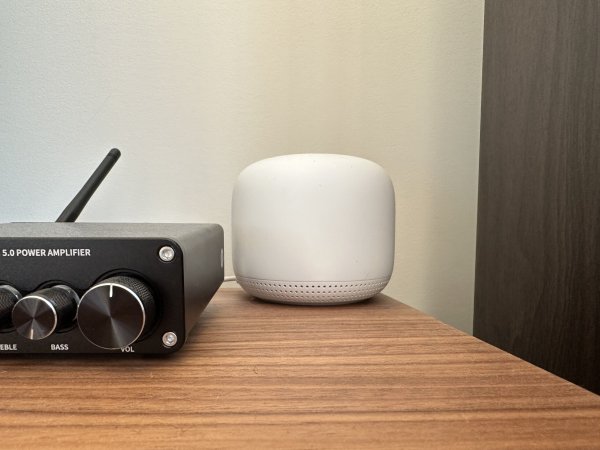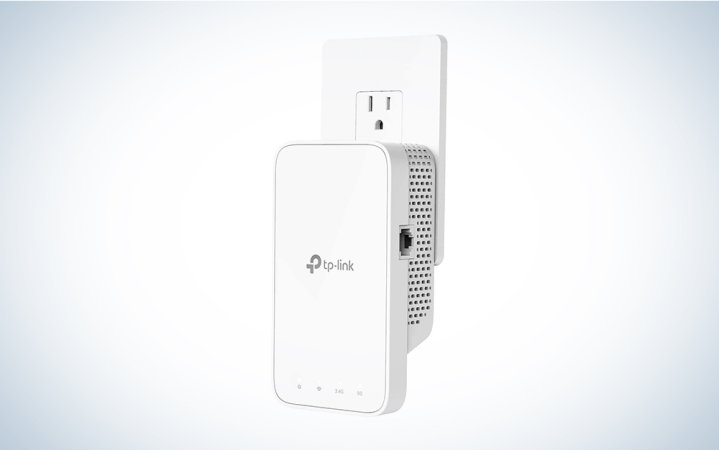We may earn revenue from the products available on this page and participate in affiliate programs. Learn more ›
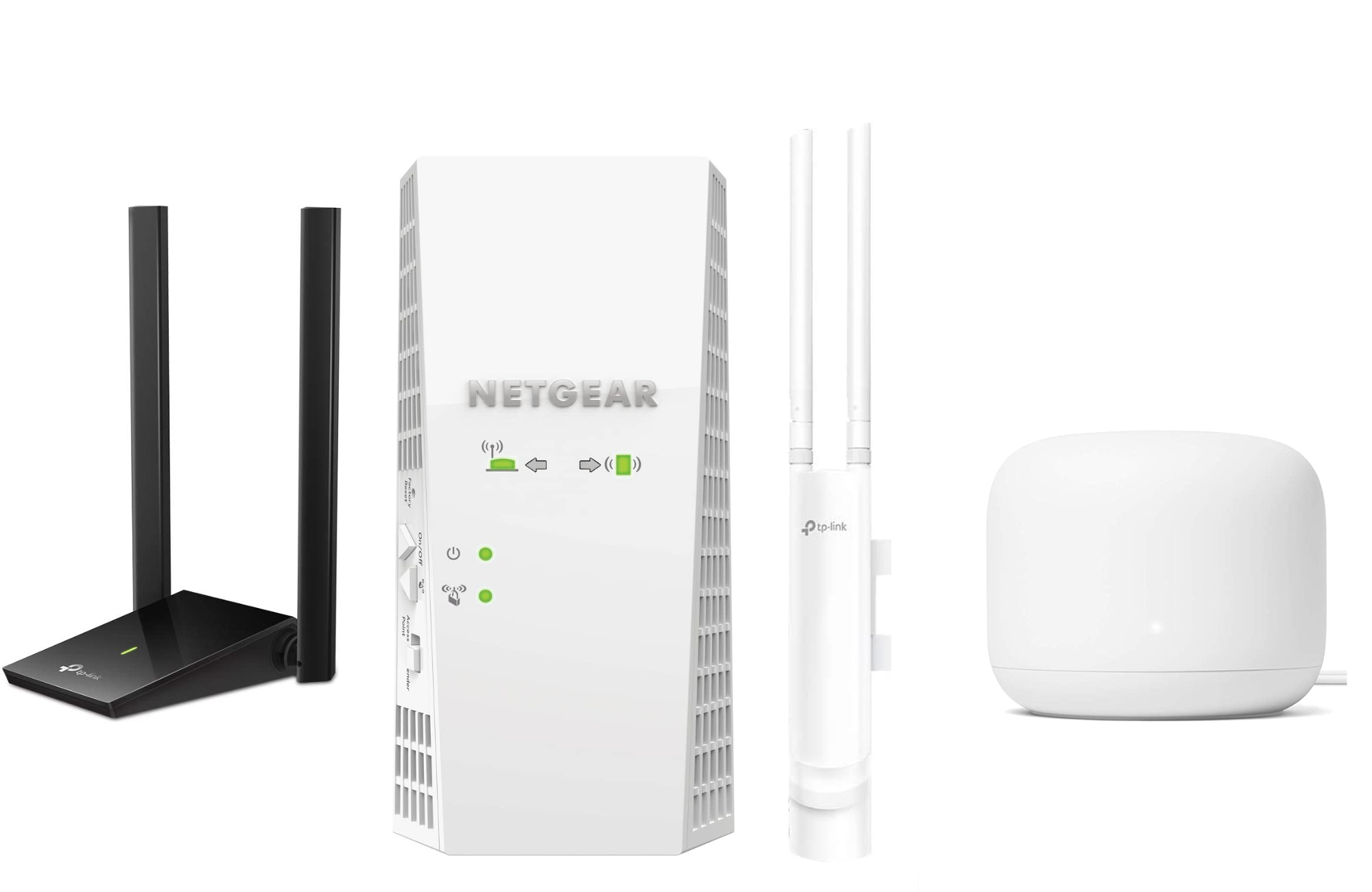
Working from home has changed how we view our personal space and cyberspace. Entire families compete for the same bandwidth, balancing work and play on one network. Doing more between your walls also means that the walls themselves—full of wiring and metal studs, electronics-packed appliances, dense materials, and decorative features—can interfere with your home network. And when an entire family is working and trying to unwind in the same home, the solution isn’t always as simple as moving to another room. Luckily, WiFi boosters suit all budgets and boundaries—whether you’re logging on indoors or outdoors, in a house full of executives and/or gamers, on a budget, or replacing an entire system. The following are some of our top selections for the best WiFi boosters that hit the (hot) spot when you need to boost productivity and range throughout your home.
- Best USB: TP-Link Archer T4U Plus USB Wireless Network Adapter
- Best dual-band: NETGEAR EX7300 WiFi Range Extender
- Best outdoor: TP-Link Omada EAP225 Outdoor Access Point
- Best mesh: Google Nest Mesh System (2nd Generation)
- Best budget: TP-Link RE230 WiFi Extender
How we chose the best WiFi boosters
The wireless routers that used to be more than enough for surfing the web and streaming Netflix are reaching their limits as we repurpose every nook and cranny into a home office, a school workstation, a yoga studio, a movie theater, or all of the above. With more and more laptops and tablets, 4K streaming services, smart TVs, etc., pulling down data, a strong connection has become the most important utility after electricity and water. We considered all of these environmental and technical factors, as well as critical reviews and user recommendations, to develop our list.
The best WiFi boosters: Reviews & Recommendations
Nobody wants to be that frozen square on the Zoom call because you’re working too far from the central router, but you also don’t want to be the one in the meeting with people walking behind them because you parked your computer too close to that living room signal. This means picking something from the following selection of the best WiFi boosters is necessary to ensure your whole space is covered.
Best USB: TP-Link Archer T4U Plus USB Wireless Network Adapter
The Quickest Fix
Why it made the cut: TP-Link’s Archer T4U Plus is a cost-effective way to extend your WiFi network without sacrificing speed.
Specs
- Speed: Up to 876Mbps
- Range: N/A
- Price: $23.99
Pros
- Multi-band
- Fast speeds
- Price
Cons
- Takes up a little more space.
Offering two adjustable, multi-directional antennae and a 1.0m USB 3.0 cable, the TP-Link AC1300 Archer T4U Plus offers flexible positioning and dual-band support, so you can pick the frequency for an optimized network experience based on your needs and location. It’s completely compatible with both Windows and Mac operating systems, and supports WPA/WPA2 encryption to secure connections. In addition, its MU-MIMO certification means the highest efficiency and minimal lag with a similarly equipped router (when in doubt, always match your WiFi extender’s specs to that of the router to ensure the strongest streams). While this USB WiFi booster cable uses USB-A (the standard, rectangular slot), there are plenty of adapters to purchase if you need a USB-C connection.
Best dual-band: NETGEAR EX7300 WiFi Range Extender
Small Footprint, Big Coverage
Why it made the cut: Netgear’s EX7300 is as powerful as a standalone WiFi router.
Specs
- Speed: 2200Mbps
- Range: 2300 Sq. Ft.
- Price: $144.99
Pros
- Excellent range
- Fantastic speeds
- Dual-band
Cons
- Price
Dual-band boosters operate on two frequency bands (2.4GHz has longer reach, but slower speed, while 5GHz has less coverage but increased data rates), and the EX7300 by Netgear (one of our favorite router brands) handles both with aplomb, offering an easy-to-install, high-throughput extender. Featuring WPS (WiFi Protected Setup), it joins your existing router with the press of one button and operates under your established network name for seamless roaming. Its 2200 Mbps, 2000-square-foot performance can handle up to 35 devices simultaneously, and an Ethernet port lets you make a direct connection to a smart TV or gaming console to ensure uninterrupted speed. Just make sure to place the booster where coverage is established and steady to amplify a uniformly strong signal.
Best outdoor: TP-Link Omada EAP225 Outdoor Access Point
Durable, Discreet
Why it made the cut: If you want to extend your home’s network to a patio or porch, TP-Link’s EAP225 is the WiFi booster to get.
Specs
- Speed: Up to 867Mbps
- Range: 984 feet
- Price: $69.99
Pros
- Size
- Durability
- Remote management
Cons
- Better options for indoor use
Housed in a discreet, dust- and water-tight IP65-rated enclosure, TP-Link Omaha AC1200 EAP225-Outdoor repeater is the best outdoor WiFi booster. Protected from all sides against the elements, the TP-Link Omaha will deliver stable coverage through anything short of a flood (it even features lightning protection). It’s got dual-band and MU-MIMO support, allowing for seamless roaming around your yard, pool, etc. When integrated with similar units, it forms a self-steering, self-healing system to reroute data and maintain connectivity in case of one device’s issue. And, featuring support for a software-defined controller, the Omaha AC1200 will use the cloud for remote configuration, meaning no need to brave the threat of real clouds if the network needs maintenance.
Best mesh: Google Nest Mesh System (2nd Generation)
The Whole House Solution
Why it made the cut: The second-generation Google Nest WiFi Router system is the most powerful option for boosting your home’s WiFi network.
Specs
- Speed: 2.2Gbps
- Range: 1,640 sq. ft.
- Price: $195
Pros
- Exceptional speed
- Google Assistant support
- Aesthetically pleasing
Cons
- May be way more powerful for your needs
- Price
If you aren’t already locked into a router and already think you may need two or more extenders to cover your space, the Google Nest AC2200 Mesh System is a no-brainer for the best mesh WiFi system. A scalable system, the $195 base package comes with a dual-band 2.2Gbps router and two access points intended to cover up to 1600 square feet (add more as needed), meaning your 4K video will stream flawlessly no matter where in the house you wander. The nodes use a proprietary channel to talk to one another, strengthening the signal between each other. And Google’s simple-to-operate iPhone/Android Home app allows the system administrator to create separate guest networks, remotely see what devices are connected, and even pause connections when necessary (I’m looking at you, homework time).
Best budget: TP-Link RE230 WiFi Extender
Cut Cost, Not Corners
Why it made the cut: If your needs are modest, TP-Link’s RE230 WiFi Extender is a cost-effective way to boost your home’s wireless network.
Specs
- Speed: Up to 433Mbps
- Range: 1,200 sq. ft.
- Price: $29.99
Pros
- Compact
- Has an Ethernet port
- Price
Cons
- Not as fast as other options
Equipped with dual-band performance and WPS compatibility, the TP-Link AC750 RE230 is the best cheap WiFi booster with a way to quickly drop in another access point for web browsing and other lower-intensity online activities. For everyday use, watching HD video, conducting Zoom calls, etc., the TP-Link RE230 should deliver up to 75Mbps and doesn’t lack much besides expense.
Things to consider when shopping for the best WiFi boosters
WiFi extenders, repeaters—no matter what you call them, the best WiFi boosters look simple because they are simple. They just take the existing wireless signal from your router and lengthen its range. Most need little more than an open wall socket to operate, and many connect with the push of a button. That doesn’t mean there aren’t things to consider, however. Is it just a single device you need to improve, or everything in the house? Is the entire network overwhelmed, or do you just want the best outdoor booster for when you need a change of scenery? Are you looking to plug something in behind the couch, or do you have desktop space? Does your router support a newer, higher throughput technology such as MU-MIMO? Here’s a rundown of important considerations and the best WiFi boosters for each situation.
Range
The main reason to get a WiFi booster extender is to, well, extend the range of your home’s wireless network. You’ll want to get a rough measurement of your home (including the porch and backyard, if applicable) to determine which WiFi range extender will work best for you. In some cases, you’ll have to get multiple extenders to have the best chance of having a large, consistent network.
Speed
A WiFi booster’s speed is typically calculated in Mbps (Megabits per second). This factor matters less than you may think because the Internet speed you actually get will be determined by the plan you’ve signed up for through your ISP (Internet Service Provider).
Bands
Imagine you’re in a hurry to be somewhere when you come up on roadwork. Someone in a reflective orange vest holds a stop sign for what seems like an eternity as a single line of traffic slowly comes toward you up the one open lane. Finally, that sign gets flipped to “SLOW,” the direction of traffic changes, and you meander your way through the same congested channel. Now imagine if your car was data and that data had to take turns all day coming and going from your router. Doesn’t sound very efficient, does it? That’s why the best WiFi boosters support dual-band technology.
A single-band system has to receive, pause, and rebroadcast on one channel, repeating the process for each data packet. With the best dual-band WiFi booster system, however, the repeater can connect with the router on one channel while amplifying the signal to another, cutting down on the overlap that leads to speed loss—an indispensable feature, to be sure.
Outdoor use
Where your router is situated is typically tied to how your internet provider’s wiring enters your house. So, unless you like stringing long, unwieldy, and unsightly Ethernet cables throughout your home, your coverage won’t always originate from a central location or be conveniently located near where you’d like to spend more time. For instance, the router might be in the front corner of the living room, as far removed from your back patio as possible. You’d love a change of scenery, to feel less boxed in, but the signal loss through all those walls is just too great to work outside. At least it was before you installed an outdoor WiFi booster.
If you have a covered area with an external wall socket, you could just plug in a standard repeater, but over time moisture and other environmental factors (even just one hard rain) can take their toll. The best all-weather WiFi extenders support multiple devices at up to 300 meters, aided by interchangeable/upgradable antennae. Mounting kits allow for easy installation on a wall or pole, and power can be delivered over Ethernet cable (allowing for placement away from walls and other exposed power sources, etc.).
Mesh WiFi system worth it
In a house with coaxial ports in multiple rooms, there are hardwired extenders you can install that can rebroadcast your router’s signal to improve range and reliability. Outside of new/custom construction, however, that’s not a very common scenario, so if you’re trying to address a large and/or multistory floor plan, a mesh system can be the best way to overcome thick walls and competing radio waves.
Think of a mesh system as a series of tiny synced cell towers that blanket your home with signal under a single, router-established name, as opposed to multiple, independently managed mini-networks that have to make handshakes and handoffs every time your phone or laptop passes from one to another. Positioned on convenient tabletops, so away from walls and obstructions, mesh WiFi system components can allow for smart roaming with minimal (typically less than 10 percent) signal loss throughout. In addition, there’s the added bonus of using one app to manage all devices, rather than having to go through multiple passwords and configuration interfaces to have everything talking.
If you’re working with a smaller space or budget, it’s still possible to get a lot of buzzwords for less investment. While $100-$200 boosters are common, a $30 plug-in option can still offer a universally compatible add-on perfect for homes in the sub-1200 square feet category.
FAQs
It’s rare to find a laptop or tablet without built-in WiFi, but, for some people, a desktop computer is the hub of their online activity. Not only is it a hassle to move a desktop that’s experiencing a weak signal, but not all of them have the latest, greatest chipsets. Whether you’re connecting with a boss, an instructor, or a group of friends, you don’t want to be the one freezing on the screen because your computer is too far from the router and has a subpar receiver buried in its guts.
Luckily, desktops have the advantage of being the most expandable of computers. You’d be hard-pressed to find one without an available USB port, and with the best USB WiFi boosters, that can be all it takes to strengthen unpredictable coverage. What a USB dongle offers is an external antenna (or antennae) that upgrades the range and/or speed of a single device. When paired with an older device, it offers access to current wireless standards (802.11n, 802.11b, 802.11a, 802.11ac, 802.11g, with 802.11ax “WiFi 6” on the horizon) to ensure a cleaner signal with any access point, and it’s a simple, affordable upgrade—easy to deploy, quick to swap between devices (say, to an older laptop that needs a boost), and an immediate solution if you’re seeing a buffering video or high ping rates for online gaming.
It all depends on your space. First, determine whether you have desktop space or just give up some wall sockets. Once you pick where you’ll put your booster, look for devices that are compliant with WPS, WPA/WPA2 encryption, 802.11ac dual-band, and MU-MIMO transmissions to get the most quickly integrated, least-congested, secure connections.
Depending on how many rooms/floors your house has, you may. Try adding one unit halfway between your router and your desired workspace and then gauge how strong your connection is. If you find dead zones, add another.
How much speed your booster needs to support depends on the bandwidth you’re paying to be delivered to your house. As long as it’s rated for 1200Mbps, you should be able to transmit a 100Mbps fiber connection consistently, while 2200Mbps will support up to 250Mbps (for reference, you need 50Mbps for a quality 4K video).
A WiFi booster shouldn’t set you back more than about $50 unless you need a very specific feature — like support for speeds around 1200Mbps.
Final thoughts on the best WiFi boosters
- Best USB: TP-Link Archer T4U Plus USB Wireless Network Adapter
- Best dual-band: NETGEAR EX7300 WiFi Range Extender
- Best outdoor: TP-Link Omada EAP225 Outdoor Access Point
- Best mesh: Google Nest Mesh System (2nd Generation)
- Best budget: TP-Link RE230 WiFi Extender
A conference room, a classroom, a movie theater, a multimedia studio: Every room in your house has become a multi-use hub of online activity, so they all need an always-on connection to ensure you’re not wasting space. When strategically placed, the best WiFi boosters shouldn’t require you to do much more than plug them in and hold a button before you’re up and running, and then will be so consistent you forget they’re there. With the right gear, that back room can finally take the front stage, regardless of where your router is.
